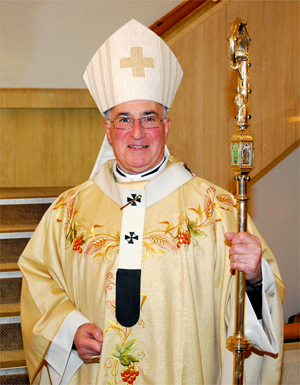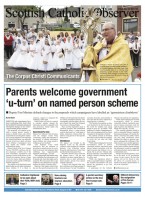August 30 | ![]() 4 COMMENTS
4 COMMENTS ![]() print
print

Archbishop Conti’s pastoral letter on the new Missal translation
The Archbishop of Glasgow says the introduction of the new English translation of the Roman Missal 'is a marvellous opportunity for us to revisit our celebration of the Liturgy'
Dear Brothers and Sisters in Christ
By now you will be aware that from the first Sunday of Advent, a new Missal will grace our altars, the text of which will, in some instances, be unfamiliar. This new Missal contains new translations into English of the original Latin texts. Every effort has been made to render them more faithful to those scriptural allusions which have sometimes been overlooked in the familiar texts to which we have become accustomed. There has also been an attempt to dignify the language we use at Mass by a return to words which might be judged as more literary, and thought by many to be more becoming for public prayer.
My concern is to encourage you to accept these changes in language, to be patient in doing so and to share my conviction that this is a marvellous opportunity for us to revisit our celebration of the Liturgy, to see its great beauty, to love it as an expression of our Catholic faith. Throughout the world and throughout time we have been prepared to make sacrifices in order to show not simply our unity of purpose in our worship, but also our harmony of expression.
I have looked to this Sunday’s liturgy to find some inspiration in addressing you and have not been disappointed. St Paul in his letter to the Romans, from which today’s epistle is taken, says: “Think of God‟s mercy my brothers, and worship him, I beg you, in a way that is worthy of thinking beings, by offering your living bodies as a Holy sacrifice, truly pleasing to God”.
This immediately suggests to me that our worship not only be thoughtful—the result of our engaging our minds and hearts with the uplifting prayer of the Church—but that it should also engage our bodies, through the postures we adopt in the course of the Mass, by the reverence we show during it, and also before and after our celebrations, recalling that the church is the house of God, not a market or a place for idle conversation. As Jesus said: “My house is a house of prayer.”
Today‟s psalm expresses beautifully my intentions in coming to Mass:
“O God, you are my God, for you I long;
For you my soul is thirsting…
So I gaze on you in the sanctuary
To see your strength and your glory…
And so I will bless you all my life
In your name I will lift up my hands.
My soul shall be filled as with a banquet,
My mouth shall praise you with joy.”
It is in that spirit that I as a priest will greet you at the beginning of Mass: “The Lord be with you,” and you will respond: “And with your spirit.”
What I want to say to you is summed up in the document of Pope Benedict published in February of 2007 at the conclusion of the gathering of bishops which addressed the subject of the Holy Eucharist in the life of the Church: “The Second Vatican Council,” wrote the Holy Father, “rightly emphasised the active, full and fruitful participation of the entire people of God in the Eucharistic celebration. The renewal carried out in these past decades has made considerable progress towards fulfilling the wishes of the Council Fathers… It should be made clear that the word „participation‟ does not refer to mere external activity during the celebration, in fact the active participation called for by the Council must be understood in more substantial terms, on the basis of a greater awareness of the mystery being celebrated and its relationship to daily life… The faithful take part in the Eucharistic liturgy not „as strangers or silent spectators‟ but as participants, in the sacred action, conscious of what they are doing, actively and devoutly‟… They should give thanks to God.” (cf Benedict XVI, Sacramentum Caritatis, Feb 22 2007)
And in words which reflect St Paul‟s words in today’s liturgy the Holy Father wrote: “Offering the immaculate victim, not only through the hands of the priest, but also together with him, [the faithful] should learn to make an offering of themselves. Through Christ, the mediator, they should be drawn, day by day, into an ever more perfect union with God and each other.”
If this is what our liturgy intends for us—what indeed the Lord himself provided for us by the institution of the Holy Mass at the Last Supper and at Calvary—then we must take this opportunity, priests and people, to renew our devotion and to respond with generosity to what is now being offered to us, and to receive with open minds the instructions and explanations our pastors give us.
In the months which remain before the new Missals are placed on our altars, we have an opportunity, week by week, to become more familiar with the texts, particularly the common parts of the Mass in which there are changes.
Cards have been made available in each parish and it would be helpful to you in coming to Mass to make sure that you have a copy of them and can follow them in the recitation of the Gloria, the Creed and in your various responses.
There are also new instructions with regard to our postures during Mass which reflect the universal custom of the Church as set down within the Missal itself. We have been more used to kneeling than standing during some parts of the Mass, whereas in most other countries, the tradition of standing has been adhered to more faithfully. Standing is of course a sign of respect in our Western culture, and it is from a standing position that we will kneel in adoration in the period following the Sanctus up until the Pater Noster.
It is also from a standing position that we should make our sign of reverence before we receive Holy Communion, approaching the altar in a dignified procession. The option of genuflecting before receiving Holy Communion is also allowed, though we recommend the acceptance of the option which has become commonplace, namely of bowing our heads before receiving Communion, as this is less likely to interrupt the flow of people and is more sensitive to the fact that there are many in our congregations who would find it difficult to genuflect without having something to hold on to.
This communion procession beautifully expresses the way in which we are a people journeying towards the Lord, for whose land and company, as the psalmist says, our ‘body pines, like a dry, weary land without water,’ for us to be refreshed on that journey by the Holy Eucharist—Christ Himself.
When we return to our places after receiving Holy Communion we can sit or kneel but what we cannot fail to do, surely, is to address in the most intimate sanctuary of our hearts, the Lord, who through the sacrament, becomes our guest. With the centurion, whose faith the Lord commended, we will repeat what we have already said in answer to the priest: “Lord, I am not worthy that you should enter under my roof, but only say the word and my soul shall be healed.”
We should spend time after communion praying for what St Paul calls in our second reading a ‘new mind’ on which our lives are to be ‘modelled.’
“This,” we are reminded, “is the only way to discover the will of God and know what is good, what it is that God wants, what is the perfect thing to do.”
In all things we struggle for perfection. “Be perfect as your heavenly Father is Perfect,” said Jesus to his disciples. In liturgy also we have the same endeavour.
With my warmest blessings,
Yours devotedly in Christ.
+Mario Conti
Archbishop of Glasgow












I wish I could share the Archbishop’s enthusiasm for the new translation. I have quite a few problems with it. For instance,if “et cum spiritu tuo” had to be translated so literally, why wasn’t the inane phrase “world without end” more literally translated as “unto the ages of ages”, as is common in most Eastern Orthodox translations,or “forever and ever”. Also, the sentences run much too long, in some cases 88 words,with multiple clauses. If I had ever submitted work like this in my secondary Latin,Greek,or English. I might have received a passing grade.
Regarding the new translation,one has to wonder why the translators were not more daring with the Pater Noster. To begin with,there is no relative clause. The Greek text simply reads “Father of us,the in the heavens”,which makes good sense in Greek or Aramaic,but not in Latin or much less English. Jerome,using dynamic equivalence,inserted the relative clause, “qui es”,which later passed into English. Further,the bread is not “daily” ,but superstantial(epiousion), a very appropriate reference to the Sacred Bread we receive at Mass. Jerome had conflated an apocryphal Gospel and used the Aramaic “mahar” (tomorrow) to produce “quotidianum”. Finally we do not pray to be delivered from generic evil,but from “the Evil One”,i.e.the Devil There is no definite article in Latin,so it was easily “under-translated” from the Greek in a generic sense. The more literal “from the Evil One” would correspond better with theology of Blessed John Paul II and Benedict XVI,about the presence of a personal source of evil in the world
I’m in favour of the new Translations as when attending Mass outside the Uk , I had problems following the mass as the English Translation was inaccurate.
As we’re making changes to the Translation of the Mass , why not go further and re-introduce the Keyrie , the Credo 3 and the Agnus dei.
One of the strengths of the Church was the following of the Mass in a Foreign Language without too much trouble. Unfortunately , due to the dilution of Religious Education in RC Schools and the Church losing it’s Universal Identity to the promotion of the Local Language , the Younger generations who attend mass , haven’t got a clue about the splendour and majesty of the Latin Mass. Surely the Order of the Mass could contain these 3 Latin Prayers.
There’s also been a Lack of devotion to Our Blessed Mother in recent years. How many Churches recite the Hail Mary after bidding prayers , My Parish of Our Lady of Lourdes doesn’t …….. so if we don’t how many others are there …… Shamefull.
Receiving communion on ones knees should not and never should be an issue and should be uninhibited by clergy, if people who can not kneel or simply wish to stand, that should not be an issue.